Table of Contents

Basil leaf is probably one of the most nutritious herbs we can ever add to our diet.
The best thing about basil is that it has some refreshing flavor appreciated by most people which makes it easy to introduce in a dish.
In this article, we gathered all the information you need to learn about basil leaf, historical overview, types of basil, basil leaf nutritional values and health benefits, possible side effects alongside tips on how to buy + use + store basil.
Basil leaf: historical overview
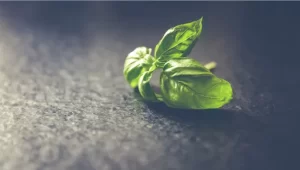
Basil is one of the most consumed herbs around the world and it belongs to the same family as lavender, sage, and mint.
We can find this herb in literature and other historical evidence that dates back more than 5000 years ago.
Most evidence point to Hunan-China as the original region for basil which could explain why China is the top consumer of basil.
However, basil leaf grow in an herbaceous plant called “Ocimum Basilicum” and belongs to the Lamiaceae family.
The plants in this family are all easy to grow indoors as it doesn’t require much sunlight.
Thanks to that, it is one of the few plants people can grow in small pots on their balconies.
Basil has long been linked to many beliefs as a miraculous healing herb, a symbol for mourning, and an ingredient to embalm mummies.
Chinese and Indians have long believed that basil is a blessing sent by god to protect the poor during life and the afterlife.
Some documents of the ancient medicinal trials show that the doctors used to think that basil is a poisonous plant.
It was only during the 16th century when the West was first introduced to basil leaf.
As a mythical land, Greece is famous for its mythical creatures and one of them is the mysterious basilisk dragon.
It is believed that basil leaf is the only remedy to cure the famous basilisk bite which turns humans into stones.
Religiously, basil is a very sacred herb in Hinduism as it is considered a manifestation of the female goddess Lakshmi.
Basil leaf famous varieties:
There are more than 100 different varieties of basil but here are some of the most famous ones:
Thai basil:

This variety of basil is uniquely used in Thai cuisine which explains the name.
As one of the sweet varieties of basil, Thai basil has smaller leaves with pointed dark green tips.
The Thai basil plant can reach heights of more than 20 inches (50cm) and grows dark purple flowers in a conical shape.
This type of basil has a unique spicy flavor that resembles fennels.
Purple Basil:
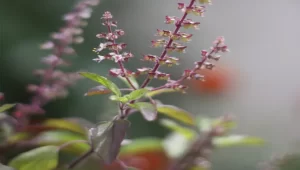
This type of basil is not only beneficial nutritionally but it can also add vibrant purple colors to your home garden.
Purple basil, just like the name suggests, grows purple stems and leaves due to the presence of powerful antioxidants called anthocyanins.
This variety of basil has a lilac flavor that is a little bit bitter and yet delicious to consume.
The plant of this basil type has its own subspecies like the purple and dark opal subspecies and can grow to reach more than 20 inches (50cm) in height.
Purple basil is perfect for garnishes and salads as it adds delicious flavors, nutrients, and pleasant colors to the dish.
Sweet Basil:
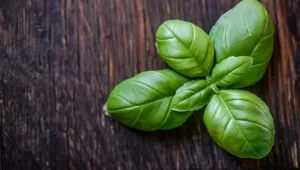
This is by far the most common type of basil leaf as it is almost available everywhere in the world.
You can find sweet basil in many dishes in different cuisines from the East to the West.
This plant can reach heights of more than 30 inches (70cm) especially if it grows in a warm environment.
This type of basil has a fresh fragrance and a delicious sweetness which makes it almost a main ingredient in Italian cuisine.
Basil lettuce:
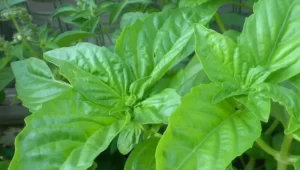
As a very unique type of basil leaf, the lettuce basil plant is very different from other basil plants.
In fact, the lettuce basil plant has wrinkled and larger leaves that resemble those of lettuce.
The flavor of basil lettuce is mild and that makes it blend well with burritos, salads, and side dishes.
Each basil leaf from the lettuce variety can be 10 inches long and 4 inches large and which is bigger than the size of your hand.
This could be due to the fact that lettuce basil flowers develop later than other varieties which allows the leaves to grow for a longer time.
Holy Basil:

In Hinduism, holy basil is considered a symbol for the goddess Tulasi AKA the avatar of Lakshmi.
Ancient Indians used the holy basil leaf by placing it on the chest of their beloved dead companions to ensure they ascend to heaven.
Because holy basil links with religious belief, this type of basil is omnipresent in Indian cuisine mostly with meat dishes.
The plant of holy basil is smaller than other types of basil leaves as it only reaches a height of 14 inches (35cm).
Holy basil leaf comes in a dark green color that is perfect to make tea or simply chopped and added to any savory dish.
If consumed raw, holy basil leaf tastes a little bitter because of that you shouldn’t use a lot of it in your recipe.
Lemon basil:
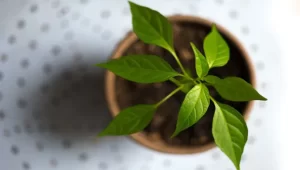
This is the favorite type of basil for those who like the flavor of lemons.
The plant of lemon basil grows up to 35 inches in height (90cm) which is almost 3 feet (1 meter).
Furthermore, a lemon basil leaf is a light green with a long shape and a smooth texture.
This type of basil is perfect to use as a garnish for your meat recipes since they combine the fresh flavor of basil with lemon flavor.
Christmas Basil:
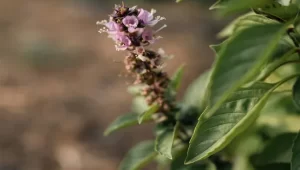
This type of basil is a cross between common sweet basil and Thai sweet basil.
The resulting basil had purple flowers and large glossy leaves that has a fruity flavor perfect for desserts, drinks, and salads.
Because of its rich flavor and mostly its pronounced fragrance, it is very common to use Christmas basil in wedding bouquets.
Cinnamon basil:

Also having purple flowers, cinnamon basil has a very delicious flavor that has a touch of spiciness.
The plant of cinnamon basil grows up to 30 inches in height (75cm) and grows purple stems with conical-shaped purple flowers.
Despite the spicy cinnamon taste of this basil type, it is still mild enough to use in your recipes.
In fact, cinnamon basil is a unique ingredient to add to Asian marinades, fruit salads, noodles, grilled vegetables…
Basil Cardinal Trainer:
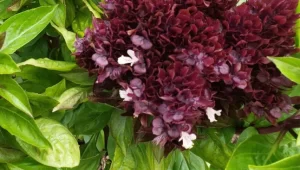
As one of the prettiest basil types, the Cardinal Trainer plant comes with red flowers packed together like a cardinal flower.
Cardinal basil leaf is small and has a light green color and a strong flavor probably stronger than most basil varieties.
Because of its pronounced flavor, it can provide great powerful seasoning for vinegar, oils, and marinades.
Spicy bush Basil:
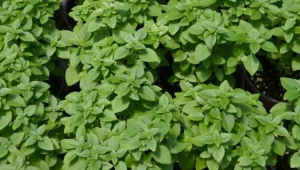
Some people call them “Spicy bush basil”, this type of basil is also perfect to grow inside on balconies.
The plant of spicy basil is small with a maximum height of 12 inches (30cm).
The spicy basil leaf is small in size with serrated edges and a very pronounced flavor perfect to use in soups, pasta, stews, and sauces.
Basil leaf nutritional values and health benefits:
Nutritional values:
As part of the mint family, basil is traditionally grown in tropical regions in Asia, India, and Africa.
The basil leaf is a great source of natural beneficial components including eugenol, estradiol, rosmarinic acid, geraniol…
When it’s fresh, basil contains all of its nutrients which gives it a strong aroma that combines fennel with pepper and mint.
These data counts for a bunch (234g) of raw basil:
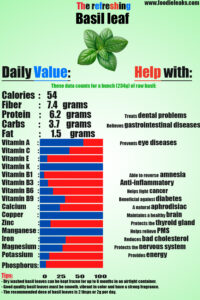
- Calories: 54
- Protein: 7.4g
- Carbs: 6.2g
- Dietary fibers: 3.7g
- Fats: 1.5g
- A vitamin: 69%
- C vitamin: 47%
- E vitamin: 12%
- K vitamin: 809%
- B1 vitamin: 7%
- B3 vitamin: 13%
- B6 vitamin: 21%
- B9 vitamin: 40%
- Calcium: 32%
- Copper: 100%
- Zinc: 17%
- Manganese: 117%
- Iron: 41%
- Magnesium: 36%
- Potassium: 15%
- Phosphorus: 10%
Health benefits:

Treats dental problems:
According to a study, dried basil leaf can be added to mustard oil to make a natural paste to use as a toothpaste to eliminate bacteria and bad breath.
The mustard oil with the dried basil paste can also be used to massage the gums which helps eliminate germs and reduce the risk of tooth decay.
Some other studies show that basil leaf components are capable of cleaning the mouth and forming a protective barrier to prevent dental issues.
Good for gastrointestinal problems:
One of the common benefits of basil is the natural treatment of gastrointestinal and liver diseases.
In fact, basil leaf consumption is linked with shorter clinical symptoms in patients with viral hepatitis.
This is mostly due to the laxative properties of basil and its ability to stimulate normal bowel movement.
Basil leaf can also be a great ingredient to treat stomach infections and digestive disorders thanks to its anti-inflammatory properties.
Prevents eye diseases:
Being exposed to the external environment our eyes are very vulnerable to external bacteria and fungi infections.
Fortunately, the use of basil leaf can easily fight these external threats and protect the eyes.
Recent studies confirm that basil leaf contain soothing and anti-inflammatory components which can fight conjunctivitis.
Also, these nutrients in basil can protect the eyes from chemical agents as well as air pollution.
Among the proven results, basil can prevent many eye diseases including vision defects, eyeball inflammation, macular degeneration, and cataracts.
You can simply get these benefits by soaking freshly crushed basil leaf in water for 30 minutes and then using the water directly on the eyes.
Able to reverse amnesia:
Traditionally, basil has long been used to treat neuralgia, seizures, anxiety, and many other neurodegenerative diseases.
Nonetheless, a recent study made by the Punjab University in India confirms that basil leaf also has anti-amnesia properties.
For instance, the powerful antioxidants found in basil can reduce oxidative stress and slow down brain activity which reduces the risk of amnesia.
Great anti-inflammatory effect:
Even though linked with a negative review, inflammation is the body’s response to a harmful infection.
The body’s immune system creates inflammation in the infected part of the body in order to eliminate foreign objects.
Nonetheless, chronic inflammation can lead to serious complications including periodontitis, atherosclerosis, high fever…
Basil leaf contains beta-caryophyllene, a type of terpene that can reduce inflammation.
In fact, studies confirm that basil can reduce swelling by more than 70% within just 24 hours.
Helps fight cancer:
As a general definition, cancer is the abnormal and uncontrollable growth of cells in one or different parts of the body.
The mutated cells can multiply rapidly and invade different tissues affecting many body functions along the way.
Nowadays, there are more than 100 types of cancer each has its own symptoms.
Despite all the treatments suggested for cancer, only a few of them succeed in healing the patient.
This is where basil comes in handy, it can prevent the spread of cancerous cells and eradicate them.
Some studies show that basil nutrients also offer protection for healthy cells during radiation therapy and chemotherapy.
Beneficial against diabetes:
About 1 in every 10 Americans is dealing with diabetes and the numbers are still growing because of our unhealthy lifestyle.
Someone dealing with diabetes means he can’t restrain his blood sugar levels from reaching dangerously high levels.
There are many symptoms of diabetes including hunger, thirst, weight changes, fatigue, male sexual dysfunction, slow wound healing…
A regular consumption of basil can indeed reduce blood sugar levels which is beneficial for diabetic patients.
Also, basil can reduce the levels of bad cholesterol sometimes caused by diabetes.
A natural aphrodisiac:
There are many causes for infertility ranging from erectile dysfunction to the quality of the sperm.
In fact, not being able to maintain an erection can happen to anyone once in while, and that is just normal.
However, if it happens very often it can have a bad effect on the man’s self-confidence which reflects badly on the relationship.
Throughout history and in many alternative medicines, basil has been used as an aphrodisiac.
Italians consider basil a symbol of love, the Portuguese offer basil as a gift for their lovers, and Indians believe that basil maintains arousal.
There are a couple of studies that confirm the efficiency of basil in reducing the risk of erectile dysfunction.
Maintains a healthy brain:
As we age, our brain becomes more and more vulnerable to dementia, Alzheimer’s, and Parkinson’s.
Nonetheless, this cognitive decline may be prevented with proper nutrition and exercise.
For instance, vitamin K in basil leaf plays an essential role in sphingolipid metabolism.
Sphingolipids are a type of molecule that offers protection to the brain from oxidative stress.
Also, basil contains copper which is another brain stimulant that reduces the risk of mental disorders.
Last but not least, basil contains a good amount of manganese which stimulates the activity of neurotransmitters.
Maintains a healthy thyroid:
The thyroid gland is the organ responsible for the production of the hormones that control vital functions and metabolism.
For instance, the thyroid gland is indirectly responsible for heart rate, body weight, muscle strength, cholesterol levels, breathing…
Hyperthyroidism can cause mood swings, nervousness, sweating, anxiety…
Hypothyroidism is responsible for fatigue, insomnia, dry skin, depression, severe menstruation…
As a good source of manganese, basil leaf supports and promotes the normal functioning of the thyroid gland.
Many studies show that getting enough manganese to the body on a daily basis will ensure optimal production of thyroid hormones.
Helps relieve PMS:
This condition describes symptoms that some women experience before or during menstruation.
Scientifically known as Premenstrual dysphoric disorder or PMS, it is estimated that almost 75% of women suffer from PMS.
The symptoms may include, irritability, pain, fatigue, mood swings, breast tenderness, food cravings, depression…
Some studies have drawn a correlation between low manganese levels and the occurrence of PMS.
This is because manganese is responsible for hormonal balance which could help overcome PMS.
In case you are dealing with such symptoms during menstruation, try consuming basil and you’ll notice great results.
Precautions before you consume basil leaf:

Basil is generally safe to consume but like every type of food, there are some exceptions.
For instance, basil is not recommended for people that deal with low blood sugar levels or low blood pressure.
This is because consuming basil leaf can interfere with blood thinners and blood sugar medications.
Basil sometimes contains estradiolone, which could increase the risk of liver cancer over a long period of time.
Doctors recommend that pregnant and nursing women should avoid consuming basil.
This herb can thin the blood which is why it is recommended to stop consuming basil two weeks before scheduled surgeries.
Uses of basil leaf:
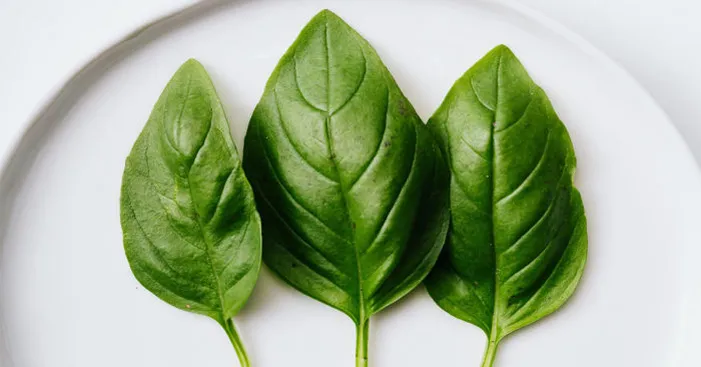
Basil is one of the most used herbs in Italian, Thai, Indonesian, Chinese, and Vietnamese cuisines:
- Mostly used in soups and pesto or simply consumed fresh in a salad.
- Chefs like to grow basil leaves in their kitchens to have an unlimited fresh supply to use in their marinara sauces and cocktails.
- Dried basil is also one of the most used spices in many cuisines due to its versatility and pleasant odor.
- Basil tea is one of the most common natural remedies in ancient Ayurveda medicine (traditional Indian medicine).
- Thanks to its powerful pleasant smell, basil is often used in air refreshing, laundry, and cleaning products.
Buying basil:
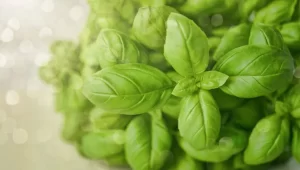
The best basil leaf you could have is the one you could pick directly from the garden.
Nonetheless, if you’re not growing basil you can still follow some tips to make sure it’s fresh.
For instance, dark spots or moldy stems on a basil leaf are a sign of spoilage and indicate that the herb is not fresh.
Instead, the leaves must be smooth, vibrant in color, and have a strong fragrance.
Once you bought fresh basil leaves, you should keep them out of direct sunlight to extend their lifespan.
In case you bought rooted basil herb, do not cut the roots but instead put it in a cup where the roots are submerged in water.
Fresh basil is best kept at room temperature and ingested within 4 days of purchase.
Storing basil:
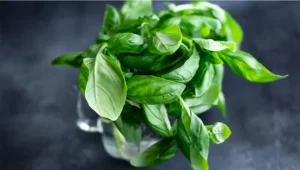
If you want to store basil for a longer time, there are a few things you need to learn.
First, basil contains high moisture content and if you chop it and expose it to the air it will lose flavor and turn black.
The best way to keep basil for a long time is to freeze them, here’s how to do it:
- Remove the leaves from the stem.
- Rinse the leaves properly and make sure you handle them with care as they are extremely delicate.
- Dry the washed basil leaves by putting them on a piece of cloth.
- Place the clean leaves on a tray and place it on the fridge overnight.
- The next day, put the leaves in an airtight freezing container and make sure they are not over-packed then place them in the freezer.
You can also extend the lifespan of basil by blending basil leaves with olive oil to obtain a puree then store it in a glass jar in the fridge.
Finally, you can bake basil leaves in the oven over low temperature for 4 hours, grind them to obtain a powder then store them in a jar for 3 years.
